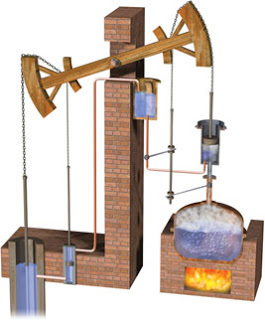The first reference to the steam engine is found in the Hellenistic period with the works of Hero of Alexandria. At that time, experiments to harness the expansion of steam were discussed.
It was a hollow metal sphere filled with water, with the arms tangential to the outlet hole: when the water is heated, it vaporizes and the water vapor comes out of the holes, through the rotation of the ball itself.
Inventor and date of creation of the steam engine
No single inventor of the steam engine can be pinpointed, nor can a precise date for its creation be determined, as its evolution has been a long and gradual process. Throughout history, numerous inventors have contributed improvements and adaptations to meet the social, economic, and political needs of each era.
However, a major milestone in its development was Thomas Newcomen's engine in 1712 , considered the first practical steam engine. Later, James Watt , in 1769, introduced key improvements such as the separate condenser, allowing for more efficient use of energy and making his design the driving force of the Industrial Revolution.
First experiments with the steam engine
In the early 17th century, Giovanni Battista della Porta's experiments were able to use steam power as a driving force.
The engineer Salomon de Caus also conducted steam engine experiments similar to those of Della Porta. In 1615, Salomon de Caus published a treatise on his system containing a steam pump.
In more recent times, the first applications of steam can be traced back to the experiments of Denis Papin and his pressure cooker in 1679. This experiment paved the way for developing the use of steam.
Origin of the first steam engine
Subsequent experiments using steam took place at the beginning of the 18th century, especially for pumping water from mines.
The water was pumped using the system devised in 1698 by Thomas Savery, using the vacuum created by the condensation of steam introduced into a container.
This experiment successfully raised water to a height of approximately 10 m. Furthermore, thanks to the invention of the piston-cylinder system, it was possible to convert steam energy into mechanical motion.
Newcomen's steam engine
 The first example of the industrial application of this concept is Thomas Newcomen's steam engine, developed in 1705. Newcomen's engine was large but not very powerful or expensive. It only achieved a back-and-forth motion. For this reason, it was used to extract water from mines.
The first example of the industrial application of this concept is Thomas Newcomen's steam engine, developed in 1705. Newcomen's engine was large but not very powerful or expensive. It only achieved a back-and-forth motion. For this reason, it was used to extract water from mines.
Initially, the steam engine operated at atmospheric pressure, so it provided very low power, and the engines had to be enormous. For installation in self-propelled vehicles, a smaller and lighter steam engine design was therefore required for the same power output.
Appearance of high-pressure steam engines
This problem led to the development of high-pressure steam engines. In high-pressure steam engines, pressure builds up inside the boiler.
This goal was later achieved with the invention of the external condenser. In the external condenser, the drawer layout and crank mechanism made it possible to convert linear motion into rotational motion.
This characteristic led to widespread use in transportation and industry. The merit of this development is attributed to the Scottish engineer James Watt in 1765.
Watt's invention had several advantages:
- Lowest cost
- Smaller dimensions
- Less energy consumption
- Greater power.
The steam engine in industry
The steam engine allowed for greater power than could be obtained with the resources available until then. This development played a key role in the Industrial Revolution.
The development of the steam engine facilitated the extraction and transportation of coal. The decline in coal mining costs contributed to a reduction in the cost of using the steam engine. The second application of the steam engine was to power the bellows in foundries in 1776, while in 1787 it was also used to spin cotton cloth.